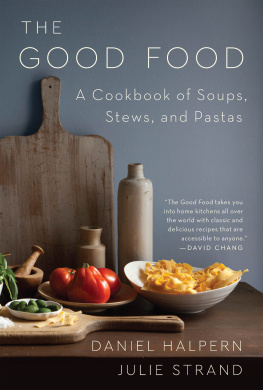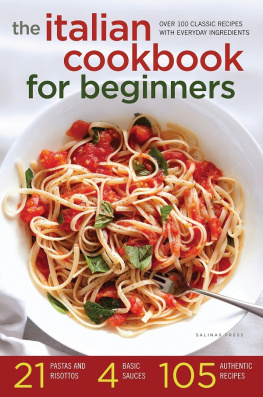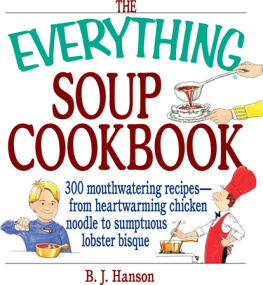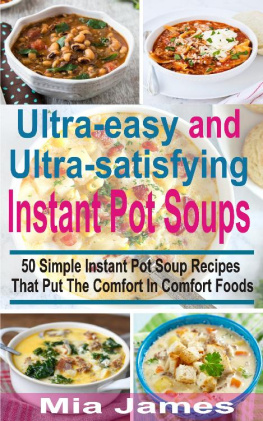For Jeanne and Mark Eating is touch carried to the bitter end. SAMUEL BUTLER II Contents I stand behind Samuel Butlers epigraph to this book: Eating is touch carried to the bitter end. Although Julie Strand and I wrote The Good Food more than thirty years ago, there have been very few meals in my kitchen these past many years that havent employed recipes from it. Yes, the recipes may seem dated, and Ive done nothing to update beyond repairing a few foolish misdirectionsand agreeing to two global replacements: begrudgingly, fresh coriander to cilantro and, happily, dried Italian mushrooms to dried porcini mushrooms. They have to be porcini in my book. And, yes, there is enough heavy cream running through these pages to float a battleshipin the eighties, we thickened soup with heavy cream and egg yolks, always with the proviso that if the liquid boiled, you would be serving breakfast.
We have unapologetically left in every tablespoon of heavy cream. There are worse things that we consume. Many of the ingredients used here were not in stores back then. Depending on where you lived, you had to go to specialty shopsIndian, Mexican, Middle Eastern, Italian, and Chineseto find items easily purchased today, such as cilantro, cardamom, some of the more exotic brown spices, harissa, tahini, fil powder, fermented black beans, balsamic vinegar, cotechino, and jarred anchovies. It goes without saying that there are numerous international recipes in The Good Food. I learned what I know about cooking mostly in Morocco and Italy, and have always been interested in new and unusual dishes from around the world.
My current favorite is a Korean dish called budae-jjigae (army base stew), a dish not for those concerned about heavy cream. I have favorites in this bookas my friend the Cardinal president of the Vatican once told me, God loves all his children. He loves some more than others. Ill limit myself to a list of five favorites: Mushroom Soup; Harira; Cold Curried Tomato Soup with Mint; Lamb Stew with Eggplant, Saffron, and Ginger; Chicken Tagine with Prunes, Onions, and Almonds; Bobotie; Penne with Cauliflower, Garlic, and Oil; Risotto with Four Cheeses; and the last recipe in the book, the odd Bistro Appetizer. Im aware thats nine. But I stand behind all of the recipes, understanding that some have withstood the test of time better than others, to clang a clich.
I love clichs almost as much as heavy cream and fresh cilantro. As the poet and avid gastrolater Charles Simic once wrote, The dream of every honest clich is to find its way into a great poem. If there turn out to be clichs in this book, at least theyll taste good. Regarding the notion of two amateurs imagining we could write a cookbook. Our dinner parties were grand events, or so they seemed then, and actually seem now. The guests, toward the end of dessert, would inevitably raise what was left of their wineglasses, and say in unison: You must write a cookbook.
And so we did. The first ten recipes were a breeze, in and out of the oven, if thats not a mixed metaphor. The next eighty not so much. That said, we did learn something, if only about how to write a first cookbookand, most important, we realized by the end of the process that we would not write another. Not to name-drop, but when our copyedited manuscript was returned to us with queries, I understood we were in trouble. There was a yellow Post-it stuck to the first stew recipe.
It read: Why dry the meat before browning it, is it wet? So I called James Beard to get his advice. He gave me his personal copyeditor. The luck of beginners! Anyway, I hope these recipes do what recipes should always do: help you eat better. Daniel Halpern, New York City, 2018 This collection of recipes is meant to be a celebration of soups, stews, and pastas. We chose these categories because they are the foods we find the most pleasurable to prepare and eatthe foods that seem to be, in some primal way, the good foodand we could find no single collection that gathered together an interesting assortment of recipes for these dishes. The Good Food is, in a sense, an anthology of our own particular tastes, gathered from a variety of sources, a catalog of dishes we have served our friends over the past fifteen years.
Some have come from friends and relatives, some have been inspired by dishes sampled at restaurants, and others have been inventedinsofar as any dish can be invented. For still other recipes, we started with ideas from classic cookbooks; like most people who spend a great deal of time in the kitchen, we have revised many such recipes over the years so that each has evolved, through many preparations, to reflect our own style of cooking. We have, naturally enough, drawn from those cuisines we most enjoy: Italian, French, Indian, Moroccan, Middle Eastern, and Eastern European. Although we appreciate Asian food, we felt the procedures and ingredients of that cuisine to be outside the scope and focus of this book. There is something extraordinarily pleasing about having a soup or a stew simmering in the kitchen, with the myriad aromas scenting the rooms of the house on a dark winter afternoon. Certainly one of the great eating pleasures is to sit down in the dusk of a warm summer evening to a cold soup laced with fresh herbs.
And one of the truly wonderful things about pasta is that it accommodates itself to any season, as well as to almost any ingredient. With as little as olive oil and garlic, or eggs and bacon, or a few vegetables, you can turn a pound of fettuccine into an extremely satisfying meal. This volume is not meant as a menu cookbook, and although it was our intention, in attempting to establish a balanced table of contents, that many of the dishes could go together, each dish has been chosen on its own merits. The Accompaniments section includes salads that can be served with many of the other recipes, a number of dishes that can be served as a first course or as part of an antipasto, and Indian condiments to go with the curries and taginesor, for the adventurous, with the European stews. We have tried to include not only classic recipes, such as Choucroute Garnie, Penne allArrabbiata, and Borscht, but also recipes that combine unusual ingredients, such as Portuguese Kale and Linguica Soup; Chicken Tagine with Prunes, Onions, and Almonds; and Spaghetti with Walnuts and Marjoram. As you read through the recipes that follow, our tastes will become clear early on.
We have a marked weakness for fresh coriander, garlic, cumin, dill, and anchovies. In fact, we both like highly spiced foods but have been careful to avoid extremes, striving for that miraculous golden mean. Although we believe each of these recipes can be followed exactly with outstanding results, every cook will undoubtedly want to add his or her own toucha little more cayenne here, a little less garlic there, and so on. One can play with a soup, stew, or pastaas one cannot with, say, a veal Prince Orloff or a cheese soufflwithout fear of total disaster. These recipes have been written so that even a relative beginner in the kitchen can follow the directions. We do assume, however, that basic procedures have been mastered and that the reader has some familiarity with the vocabulary of cooking.
We do not argue for any particular school of cooking. This book simply reflects our personal taste, which, we believe, is eclectic. The sole criterion for inclusion in The Good Food is the proven excellence of a dish. Daniel Halpern and Julie Strand, 1985 It goes without saying that the better the ingredients, the better the dish. We believe that it is usually best to avoid the supermarket and buy your meat from a good butcher and your vegetables and fresh herbs from the greengrocer (if you cant grow your own). During some seasons fresh herbs may not be available; the recipes indicate when dried herbs may be substituted, but the difference is considerable, and if there is any way to find fresh herbs, do so.
Next page





